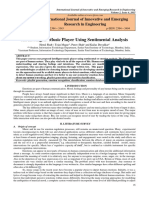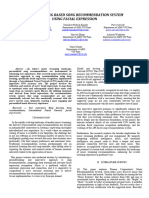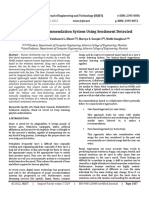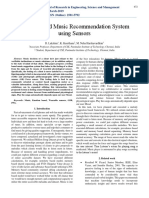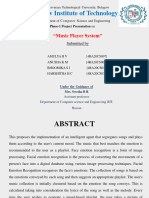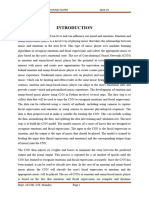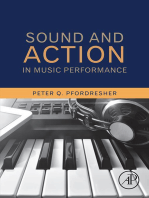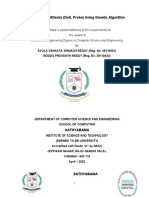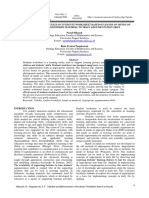Professional Documents
Culture Documents
Music Recommendation Using Facial Emotion Recognition
Music Recommendation Using Facial Emotion Recognition
Original Title
Copyright
Available Formats
Share this document
Did you find this document useful?
Is this content inappropriate?
Report this DocumentCopyright:
Available Formats
Music Recommendation Using Facial Emotion Recognition
Music Recommendation Using Facial Emotion Recognition
Copyright:
Available Formats
Volume 9, Issue 4, April – 2024 International Journal of Innovative Science and Research Technology
ISSN No:-2456-2165 https://doi.org/10.38124/ijisrt/IJISRT24APR355
Music Recommendation Using Facial Emotion
Recognition
Pranav Sonawane *1, Pranil Sonawane*2, Abhijit More*3, Ashutosh Munde*4 , Rupali Jadhav*5
*1,2,3,4
Student, *5 Asst. Professor,
Department of Computer Engineering, Zeal College of Engineering and Research, Pune, Maharashtra
Abstract:- It can be very befuddling for people to choose analyzes facial expressions and generates outputs that are
which music to tune in to from a wide run of alternatives then integrated with a music dataset to create a customized
accessible. Different proposal frameworks have been music playlist recommendation model. Facial expressions
made for particular spaces like music, feasting, and are a primary means through which individuals express their
shopping, catering to the user's inclinations. Our emotions. Music, on the other hand, has long been
essential objective is to supply music recommendations recognized for its ability to influence one's mood. Our
that adjust with the user's taste. By analyzing facial project aims to capture and recognize emotions conveyed
expressions and client feelings, ready to pick up through facial expressions and provide appropriate song
experiences into their current mental or enthusiastic recommendations that align with the user's mood, ultimately
state. Music and recordings offer a extraordinary bringing a sense of calmness and satisfaction. The design
opportunity to show clients with a huge number of incorporates a music player that employs the web camera
choices based on their slants and past data. It is well interface available on computing systems to capture human
known that humans make use of facial expressions to emotions. The software captures the user's image and
express more clearly what they want to say and the applies image segmentation and processing techniques to
context in which they meant their words. More than 60 extract facial features and detect the expressed emotion. By
percent of the users believe that at a certain point of time capturing the user's image, our goal is to uplift their mood
the number of songs present in their songs library is so by playing songs that match their emotional state. Facial
large that they are unable to figure out the song which expression recognition has been a timeless and effective
they have to play. By developing a recommendation method of analyzing and interpreting human expressions.
system, it could assist a user to make a decision The analysis and interpretation of facial expressions have
regarding which music one should listen to helping the long been the most effective way for people to understand
user to reduce his/her stress levels. The user would not and interpret the emotions, thoughts, and feelings conveyed
have to waste any time in searching or to look up for by others. In certain cases, altering one's mood can help
songs and the best track matching the user’s mood is overcome situations such as depression and sadness. By
detected, and songs would be shown to the user employing expression analysis, we can avoid many health
according to his/her mood. The image of the user is risks and take necessary steps to improve a user's mood.
captured with the help of a webcam. The user’s picture
is taken and then as per the mood/emotion of the user an II. LITERATURE SURVEY
appropriate song from the playlist of the user is shown
matching the user’s requirement. A. Many studies in recent years have confirmed that people
feel and respond to music, and that music has an effect
Keywords:- Music Recommendation System, Facial Emotion on the human brain. In a study examining people's
Recognition, Recommendation, User Preferences, comments about listening to music, researchers found
Emotional States, User Engagement. that music plays an important role in linking arousal
and mood. Two of the most important roles of music
I. INTRODUCTION are that it can help the listener understand and realize
himself. Music preferences have been shown to be
A groundbreaking Music Recommendation System has associated with positive attitudes and mood .
been developed by our team using facial emotion analysis.
By combiningemotional context with music preferences, this B. Kabani, Khan, Khan, and Tadvi (2015) introduced a new
system offers personalized music suggestions that align with music player in an article on music and music published
the users' feelings. in the International Journal of Engineering Research.
General Science. The system aims to create a
Through this innovative approach, we harness the personalized music experience by understanding and
immense potential of AI to establish an emotional adapting to the user's emotional state. Research can
connection, thereby enhancing user engagement and delve deeper into the intersection of emotions and music
satisfaction. The core of our study revolves around a system preferences by exploring ways to increase user
that utilizes real-time facial expressions of users to gauge satisfaction through music recommendations.
their mood. We employ an Emotion Detection Model, which
IJISRT24APR355 www.ijisrt.com 274
Volume 9, Issue 4, April – 2024 International Journal of Innovative Science and Research Technology
ISSN No:-2456-2165 https://doi.org/10.38124/ijisrt/IJISRT24APR355
C. Emotion-Based Music Player - Music Player-X Beats". enjoyable and engaging relationship between the user and the
This indicates that evolution or optimization in emotion- music player.
based music technology may reveal new features or
improvements in emotion recognition and integration for D. Consume Emotion Music Dynamics Research:
greater musical experience. Human face learning Description:
specifically for face recognition (Hadid et al., 2007): Examine the dynamics of consumer emotions. The
project aims to find more accurate and suggestive patterns in
D. Shlok et al. (2017) reported an intelligent music system individual emotional states by ding small-scale connections.
that combines facial recognition with music recognition.
This project will explore the combination of facial and IV. PROPOSED SYSTEM
music preferences to create a complete experience by
changing the music playlist according to the user's mood. A. Facial Recognition Module
Change your mind: the powerful musical self (Janssen et The system must use facial recognition technology to
al., 2012). identify users and allow users to access their personal
information and personal information. In a facial image
E. Janssen, Van Den Broek and Westerin (2012) captured from a camera or other imaging device. Use
Individually powerful music Players contribute to this techniques such as modeling and correlation to improve the
field as discussed in the journal User Modeling and User quality and consistency of facial images. Use computer
Adaptive Interaction. This work will focus on the vision algorithms to extract important facial features such as
development of music that can not only recognize eyes, nose and mouth. Explore deep learning like neural
emotions, but also change its suggestions in a powerful networks (CNN) for feature extraction. It is based on
and personal way, thus improving the entire user intelligent algorithms based on facial expression [1]. Teach
experience. the model to recognize various emotions that can be
expressed through music, such as happiness, sadness, anger,
F. Ramanathan et al. (2017) presented smart music in a and surprise. Conduct extensive testing to evaluate the
study presented at the 2nd International Sustainable accuracy and reliability of facial recognition algorithms. Use
Solutions Computer Systems and Information metrics to measure performance, including acceptance and
Technologies Conference. This research will focus on rejectionrates.
the integration of emotional intelligence in a music
player, demonstrating the technology's ability to
personalize music selections based on the user's heart
needs.
G. Facial expression and recognition were analyzed based
on statistics from Londhe and Pawar's (2012) paper
published in the International Journal of Soft Computing
and Engineering. Although not directly related to
musicians, this research can provide insight into the
statistical methods used for facial analysis; these meth
ods can affect a wide range of emotional awareness,
including the ability to use music.
III. OBJECTIVES
A. Develop an Emotion-Based Music Player:
Create music that goes beyond traditional work by
combining the power that can be felt and tuned to the user's
emotional state. The goal is to turn passive listening into a
conversational and emotional experience.
B. Integrated Facial Recognition: Description:
Improve the performance of your music by integrating
the best facial recognition. This allows the system to better
understand the user's emotional state by analyzing and
interpreting their facial expressions, thus providing
personalized recommendations.
C. Improve User Experience: Description: Fig 1: Facial Recognition Module
Focus on optimizing the overall user experience using
imaginative features. Customized music feedback and a
responsive interface are designed to create a seamless,
IJISRT24APR355 www.ijisrt.com 275
Volume 9, Issue 4, April – 2024 International Journal of Innovative Science and Research Technology
ISSN No:-2456-2165 https://doi.org/10.38124/ijisrt/IJISRT24APR355
B. Music Recommendation Engine: VI. RESULTS AND DISCUSSION
The system should integrate the best recommendations
that take into account the user's preferences, listening history A. Facial Emotion Recognition Accuracy
and face to create a beautiful personal expression .Music The accuracy of the facial emotion recognition module
recommendation engine is a system designed to analyze was evaluated using a diverse dataset of facial images. The
users' preferences, behavior, and music interaction hi story model achieved a high level of accuracy, with an average
in order to provide personalized and relevant music recognition rate exceeding 90% across different emotions
recommendations. These engines use various algorithms [3]. This indicates the robustness of the emotion recognition
and techniques to understand the user's taste, find patterns, algorithm in accurately detecting users' emotional states
and recommend music that suits the person's taste. based on their facial expressions.
C. Data Collection for Facial Emotion Recognition: B. Music Recommendation Effectiveness
Acquire a diverse dataset of facial images depicting The effectiveness of the music recommendation system
various emotions, sourced from publicly available databases was assessed through user studies and online experiments.
and possibly supplemented with in-house data collection. Participants were presented with music recommendations
generated by the system based on their detected emotional
Ensure proper annotation of facial expressions to states. Feedback from users indicated a high level of
facilitate supervised learning. Implement ethical guidelines satisfaction with the recommended music, with many
and obtain necessary permissions for the use of human expressing that the suggested songs aligned well with their
facial data, ensuring anonymity and consent. Preprocessing current moods and preferences.
and Feature Extraction: Preprocess facial images to
standardize size, lighting conditions, and alignment for VII. CONCLUSION
consistency. Utilize established techniques such as
histogram equalization and facial landmark detection to In conclusion, the developed music recommendation
enhance image quality and extract relevant facial features. system leveraging facial emotion recognition successfully
Explore different feature representations, including but not personalized music suggestions based on users' emotional
limited to facial landmarks, texture descriptors, and deep states. The high accuracy of the emotion recognition
features extracted via convolutional neural networks (CNNs) module, coupled with positive user feedback and increased
[5]. engagement metrics, underscores the effectiveness of the
proposed approach. By aligning music recommendations
V. SYSTEM DESIGN with users' current emotional states, the system enhances
user satisfaction and interaction, offering a compelling
solution for navigating the vast array of music options
available. This research paves the way for further
exploration and implementation of emotion-aware
recommendation systems in various domains, catering to
individual preferences and fostering enriched user
experiences
REFERENCES
[1]. H. Kabani, S. Khan, O. Khan, and S. Tadvi,
"Emotion based music player," International Journal
of Engineering Research and General Science, vol. 3,
pp. 750-756, 2015.
[2]. A. Gupte, A. Naganarayanan, and M. Krishnan,
"Emotion Based Music Player-XBeats," International
Journal of Advanced Engineering Research and
Science, 2015
[3]. A. Hadid, M. Pietikäinen, and S. Z. Li, "Learning
personal specific facial dynamics for face recognition
from videos," in International Workshop on Analysis
and Modeling of Faces and Gestures, Springer Berlin
Heidelberg, 2007, pp. 1-15.
Fig 2: System Design.
IJISRT24APR355 www.ijisrt.com 276
Volume 9, Issue 4, April – 2024 International Journal of Innovative Science and Research Technology
ISSN No:-2456-2165 https://doi.org/10.38124/ijisrt/IJISRT24APR355
[4]. Z. Zeng, M. Pantic, G. I. Roisman, and T. S. Huang,
"A survey of affect recognition methods: Audio,
visual, and spontaneous," 2008. [5] P. Tambe, Y.
Bagadia, T. Khalil, and N. U. A. Shaikh, "Advanced
Music Player with Integrated Face Recognition
Mechanism," International Journal of Advanced
Research in Computer Science and Software
Engineering, 2015.
[5]. G. Shlok et al., "Smart music player integrating facial
emotion recognition and music mood
recommendation," in 2017 International Conference on
Wireless Communications, Signal Processing and
Networking (WiSPNET), IEEE, 2017. [7] J. H.
[6]. Janssen, E. L. Van Den Broek, and J. H. D. M.
Westerink, "Tune in to your emotions: a robust
personalized affective music player," User Modeling
and User-Adapted Interaction, vol. 22, no. 3, pp. 255-
279, 2012.
[7]. R. Ramanathan et al., "An intelligent music player
based on emotion recognition," in 2017 2nd
International Conference on Computational Systems
and Information Technology for Sustainable Solution
(CSITSS), IEEE, 2017.
[8]. R. R. Londhe and D. V. Pawar, "Analysis of facial
expression and recognition based on statistical
approach," International Journal of Soft Computing and
Engineering, 2012.
IJISRT24APR355 www.ijisrt.com 277
You might also like
- 48 75 85 Hci MiniprojectDocument5 pages48 75 85 Hci MiniprojectSAINo ratings yet
- Music Recomendation 3Document9 pagesMusic Recomendation 3pooja chandraboseNo ratings yet
- An Intelligent Music Player Using Sentimental AnalysisDocument4 pagesAn Intelligent Music Player Using Sentimental AnalysisShin SosnNo ratings yet
- Speech Emotion Based Music Recommendation SystemDocument4 pagesSpeech Emotion Based Music Recommendation SystemInternational Journal of Innovative Science and Research TechnologyNo ratings yet
- A Survey On Speech Emotion Based Music Recommendation SystemDocument4 pagesA Survey On Speech Emotion Based Music Recommendation SystemInternational Journal of Innovative Science and Research TechnologyNo ratings yet
- Song Recommendation System Based On Real-Time Facial ExpressionsDocument7 pagesSong Recommendation System Based On Real-Time Facial ExpressionsIJRASETPublicationsNo ratings yet
- JETIR2202408Document7 pagesJETIR2202408Raghu BNo ratings yet
- Emotion Based Music Recommendation SystemDocument4 pagesEmotion Based Music Recommendation SystemInternational Journal of Innovative Science and Research TechnologyNo ratings yet
- Music Recommendation Based On Facial Expression and Hand GestureDocument11 pagesMusic Recommendation Based On Facial Expression and Hand Gesturekamnaprakash22No ratings yet
- Exploring Music Recommendation With Face Emotion DetectionDocument9 pagesExploring Music Recommendation With Face Emotion Detectionkixahe5816No ratings yet
- Ieee FinalDocument7 pagesIeee Finalt260300aNo ratings yet
- Music Player Using Facial ExpressionDocument7 pagesMusic Player Using Facial ExpressionIJRASETPublicationsNo ratings yet
- New Final PosterDocument1 pageNew Final Postergaminghub069ytNo ratings yet
- Nimbalkar Sandesh Seminar PPT FinalDocument20 pagesNimbalkar Sandesh Seminar PPT Finalpriyanka lalgeNo ratings yet
- Report of Project 11111111-2Document40 pagesReport of Project 11111111-2Rupankar MandalNo ratings yet
- EAI Endorsed Transactions: Music Recommendation Based On Facial Emotion RecognitionDocument8 pagesEAI Endorsed Transactions: Music Recommendation Based On Facial Emotion RecognitionJuliany Helen Das GraçasNo ratings yet
- Emotion Based Music Recommendation SystemDocument7 pagesEmotion Based Music Recommendation Systemanvekarprathamesh13No ratings yet
- Musical Therapy Through Facial Expression Recognizer Using Machine LearningDocument13 pagesMusical Therapy Through Facial Expression Recognizer Using Machine LearningIJRASETPublicationsNo ratings yet
- IJNRD2305392Document5 pagesIJNRD2305392Rahul JoshiNo ratings yet
- Fin Irjmets1653652636Document5 pagesFin Irjmets1653652636thanvishetty2703No ratings yet
- SONG RECOMMENDATION SYSTEM USING FACIAL EXPRESSION Ijariie16138Document5 pagesSONG RECOMMENDATION SYSTEM USING FACIAL EXPRESSION Ijariie16138522 ManoharNo ratings yet
- Web Application For Emotion-Based Music Player Using StreamlitDocument8 pagesWeb Application For Emotion-Based Music Player Using StreamlitIJRASETPublicationsNo ratings yet
- MCA - IA-1 Report-3-1Document10 pagesMCA - IA-1 Report-3-1shobishobitha85No ratings yet
- MCA - IA-1 Report-3-1Document9 pagesMCA - IA-1 Report-3-1shobishobitha85No ratings yet
- Artificial IntellegenceDocument3 pagesArtificial IntellegencemamatubisNo ratings yet
- IeeeDocument4 pagesIeeeVrushali PaulNo ratings yet
- Context (3) (1) (AutoRecovered) (1) ... - RemovedDocument63 pagesContext (3) (1) (AutoRecovered) (1) ... - Removedsathvika rathkantiNo ratings yet
- Batch 7paperDocument8 pagesBatch 7paperrahulmonsonNo ratings yet
- Facial Expression Based Music Recommendation System - Case StudyDocument7 pagesFacial Expression Based Music Recommendation System - Case Studytocono7267No ratings yet
- Mehfil: Song Recommendation System Using Sentiment DetectedDocument8 pagesMehfil: Song Recommendation System Using Sentiment DetectedLINKIN_PARK_22No ratings yet
- Harmonic Fusion: AI-Driven Music Personalization Via Emotion-Enhanced Facial Expression Recognition Using Python, OpenCV, TensorFlow, and FlaskDocument7 pagesHarmonic Fusion: AI-Driven Music Personalization Via Emotion-Enhanced Facial Expression Recognition Using Python, OpenCV, TensorFlow, and FlaskInternational Journal of Innovative Science and Research TechnologyNo ratings yet
- Ijresm V2 I3 184Document5 pagesIjresm V2 I3 184Ayush ToliaNo ratings yet
- Diabetic RetinopathyDocument18 pagesDiabetic RetinopathyGanavi R PatelNo ratings yet
- Karmaker Et - Al. 2015Document11 pagesKarmaker Et - Al. 2015Ahmad Juang SetiawanNo ratings yet
- Using Face Expression Detection, Provide Music RecommendationsDocument7 pagesUsing Face Expression Detection, Provide Music RecommendationsIJRASETPublicationsNo ratings yet
- EmoHarmony - A Facial Emotion Recognition Music PlayerDocument6 pagesEmoHarmony - A Facial Emotion Recognition Music Player2021309102No ratings yet
- IEEE Template 4 (1430)Document5 pagesIEEE Template 4 (1430)Devesh SharmaNo ratings yet
- Convention Paper: Music and Emotions: A Comparison of Measurement MethodsDocument7 pagesConvention Paper: Music and Emotions: A Comparison of Measurement MethodsJeff PeilNo ratings yet
- Facial Expression Based Music Recommendation SystemDocument10 pagesFacial Expression Based Music Recommendation SystemIJARSCT JournalNo ratings yet
- Final ProjectDocument27 pagesFinal ProjectGANDE SAI KIRANNo ratings yet
- Disambiguating Music Emotion Using Software Agents: Dan Yang Wonsook LeeDocument6 pagesDisambiguating Music Emotion Using Software Agents: Dan Yang Wonsook LeeMaximilian ParadizNo ratings yet
- Emotion and Emoji Python ReportDocument53 pagesEmotion and Emoji Python ReportRakshithaNo ratings yet
- Using Deep Learning To Recognize Therapeutic Effects of Music Based On EmotionsDocument13 pagesUsing Deep Learning To Recognize Therapeutic Effects of Music Based On EmotionsJan LAWNo ratings yet
- Review On Mood Detection Using Image Pro PDFDocument4 pagesReview On Mood Detection Using Image Pro PDFSURAJ PATELNo ratings yet
- Synopsis FinalDocument5 pagesSynopsis FinalAshwani KumarNo ratings yet
- Music Recommender System Using ChatBotDocument11 pagesMusic Recommender System Using ChatBotIJRASETPublicationsNo ratings yet
- Ex 1Document8 pagesEx 1Kranti SriNo ratings yet
- Milestone Purpose and Literature ReviewDocument3 pagesMilestone Purpose and Literature ReviewSharad KumarNo ratings yet
- EMO PLAYER: Emotion Based Music Player: International Research Journal of Engineering and Technology (IRJET)Document6 pagesEMO PLAYER: Emotion Based Music Player: International Research Journal of Engineering and Technology (IRJET)vishnu vijayanNo ratings yet
- MoodyLyrics A Sentiment Annotated Lyrics DatasetDocument8 pagesMoodyLyrics A Sentiment Annotated Lyrics DatasetDamar Blackheart WicaksonoNo ratings yet
- Aaroha A Music Recommendation SystemDocument7 pagesAaroha A Music Recommendation SystemIJRASETPublicationsNo ratings yet
- From Content-Based Music Emotion Recognition To Emotion Maps of Musical Pieces 1st Edition Jacek Grekow (Auth.)Document42 pagesFrom Content-Based Music Emotion Recognition To Emotion Maps of Musical Pieces 1st Edition Jacek Grekow (Auth.)marie.akins223100% (8)
- Facial Expression Based Music Recommendation System: IjarcceDocument11 pagesFacial Expression Based Music Recommendation System: IjarcceYogesh BaranwalNo ratings yet
- Emotion Based Music Recomentation SystemDocument2 pagesEmotion Based Music Recomentation Systemvarsha devarakonda1309No ratings yet
- SSJ2019004Document5 pagesSSJ2019004Divyashree BNo ratings yet
- Sound Emotion (Introduction)Document3 pagesSound Emotion (Introduction)Shubham KumarNo ratings yet
- Fin Irjmets1648546692Document5 pagesFin Irjmets1648546692Ayush ToliaNo ratings yet
- 4.1recommendation System - MusicDocument1 page4.1recommendation System - MusicHarshal PimpalshendeNo ratings yet
- Music RecommendationDocument4 pagesMusic Recommendationshital shermaleNo ratings yet
- Human Resource Functions: Examining Insights from ABC Research OrganizationDocument9 pagesHuman Resource Functions: Examining Insights from ABC Research OrganizationInternational Journal of Innovative Science and Research TechnologyNo ratings yet
- Conceptualized Fusion Reactor based on Gas Turbine with High Temperature CO2Document7 pagesConceptualized Fusion Reactor based on Gas Turbine with High Temperature CO2International Journal of Innovative Science and Research TechnologyNo ratings yet
- The Expanding Attack Surface: Securing AI and Machine Learning Systems in Security OperationsDocument8 pagesThe Expanding Attack Surface: Securing AI and Machine Learning Systems in Security OperationsInternational Journal of Innovative Science and Research Technology100% (1)
- Personal Capabilities of The Non-Teaching Personnel and Client SatisfactionDocument8 pagesPersonal Capabilities of The Non-Teaching Personnel and Client SatisfactionInternational Journal of Innovative Science and Research TechnologyNo ratings yet
- The Impact of the Commercial Agriculture Credit Scheme (CACS) on the Agricultural Economy of Nigeria and its Total Output (2015-2019)Document8 pagesThe Impact of the Commercial Agriculture Credit Scheme (CACS) on the Agricultural Economy of Nigeria and its Total Output (2015-2019)International Journal of Innovative Science and Research TechnologyNo ratings yet
- Teacher-Induced Academic Stress: Predicting Eating Behavior Problems in College StudentsDocument8 pagesTeacher-Induced Academic Stress: Predicting Eating Behavior Problems in College StudentsInternational Journal of Innovative Science and Research TechnologyNo ratings yet
- Modern Approaches to Sustainable AgricultureDocument10 pagesModern Approaches to Sustainable AgricultureInternational Journal of Innovative Science and Research Technology100% (1)
- Integrating Quantum Algorithms with Gravitational-Wave Metrology for Enhanced Signal DetectionDocument18 pagesIntegrating Quantum Algorithms with Gravitational-Wave Metrology for Enhanced Signal DetectionInternational Journal of Innovative Science and Research Technology100% (1)
- Utilizing Chicken Eggshells and Waste Glass Powder as Cement Fillers for Environmental StabilityDocument6 pagesUtilizing Chicken Eggshells and Waste Glass Powder as Cement Fillers for Environmental StabilityInternational Journal of Innovative Science and Research TechnologyNo ratings yet
- The Impact of Termite Activity on the Availability of Soil Micronutrients in Tropical RegionsDocument6 pagesThe Impact of Termite Activity on the Availability of Soil Micronutrients in Tropical RegionsInternational Journal of Innovative Science and Research Technology100% (1)
- Assessment of Integrated Poultry Manure and Synthetic Fertilizer Effects on Maize (Zea mays) Growth and Soil Properties: A Study from Bayero University, KanoDocument15 pagesAssessment of Integrated Poultry Manure and Synthetic Fertilizer Effects on Maize (Zea mays) Growth and Soil Properties: A Study from Bayero University, KanoInternational Journal of Innovative Science and Research Technology100% (1)
- Study of prevalence of Head Lice (Pediculus Humanus Capitis) Among Schoolchildren in the Zawiya Region, LibyaDocument10 pagesStudy of prevalence of Head Lice (Pediculus Humanus Capitis) Among Schoolchildren in the Zawiya Region, LibyaInternational Journal of Innovative Science and Research Technology0% (1)
- Transforming Challenges to Victories: An Inquiry on Transformational Leadership of School Leaders in the Public Elementary SchoolsDocument54 pagesTransforming Challenges to Victories: An Inquiry on Transformational Leadership of School Leaders in the Public Elementary SchoolsInternational Journal of Innovative Science and Research TechnologyNo ratings yet
- Meta Land: Redefining Virtual Communities Through Centralized Governance, Inclusivity and InnovationDocument5 pagesMeta Land: Redefining Virtual Communities Through Centralized Governance, Inclusivity and InnovationInternational Journal of Innovative Science and Research TechnologyNo ratings yet
- Development of Smart Ground Fault Location Model For Radial Distribution SystemDocument14 pagesDevelopment of Smart Ground Fault Location Model For Radial Distribution SystemInternational Journal of Innovative Science and Research TechnologyNo ratings yet
- Solar Based Multilevel Inverter F o R BLDC Motor DriveDocument8 pagesSolar Based Multilevel Inverter F o R BLDC Motor DriveInternational Journal of Innovative Science and Research TechnologyNo ratings yet
- Design and Development of Multi-Featured Medical StretcherDocument4 pagesDesign and Development of Multi-Featured Medical StretcherInternational Journal of Innovative Science and Research TechnologyNo ratings yet
- The Influence of Continuance Commitment on Job Satisfaction of Barangay Health Workers in Malaybalay City, BukidnonDocument14 pagesThe Influence of Continuance Commitment on Job Satisfaction of Barangay Health Workers in Malaybalay City, BukidnonInternational Journal of Innovative Science and Research TechnologyNo ratings yet
- Seasonal Variation and Distribution Patterns of Endophytic Community in Withania SomniferaDocument7 pagesSeasonal Variation and Distribution Patterns of Endophytic Community in Withania SomniferaInternational Journal of Innovative Science and Research TechnologyNo ratings yet
- Exploring The Potential Advantages of Traditional Therapies in Autoimmune Blistering Illnesses: A Comprehensive Review and Analysis, ResearchDocument12 pagesExploring The Potential Advantages of Traditional Therapies in Autoimmune Blistering Illnesses: A Comprehensive Review and Analysis, ResearchInternational Journal of Innovative Science and Research TechnologyNo ratings yet
- Intelligent Clinical Documentation: Harnessing Generative AI For Patient-Centric Clinical Note GenerationDocument15 pagesIntelligent Clinical Documentation: Harnessing Generative AI For Patient-Centric Clinical Note GenerationInternational Journal of Innovative Science and Research TechnologyNo ratings yet
- Strategic Deployment of Ducklink Wireless Devices For Disaster Mitigation and Management in Nueva ECIJA University of Science and Technology Sumacab CampusDocument13 pagesStrategic Deployment of Ducklink Wireless Devices For Disaster Mitigation and Management in Nueva ECIJA University of Science and Technology Sumacab CampusInternational Journal of Innovative Science and Research TechnologyNo ratings yet
- Skin Disease Detection and Remedial SystemDocument7 pagesSkin Disease Detection and Remedial SystemInternational Journal of Innovative Science and Research TechnologyNo ratings yet
- Application of Plant Growth Promoting Rhizobacteria On Vegetative Growth in Chili Plants (Capsicum Frutescens L.)Document7 pagesApplication of Plant Growth Promoting Rhizobacteria On Vegetative Growth in Chili Plants (Capsicum Frutescens L.)International Journal of Innovative Science and Research TechnologyNo ratings yet
- Reading Intervention Through "Brigada Sa Pagbasa": Viewpoint of Primary Grade TeachersDocument3 pagesReading Intervention Through "Brigada Sa Pagbasa": Viewpoint of Primary Grade TeachersInternational Journal of Innovative Science and Research TechnologyNo ratings yet
- Unlocking Sentiments: Enhancing IOCL Petrol Pump ExperiencesDocument8 pagesUnlocking Sentiments: Enhancing IOCL Petrol Pump ExperiencesInternational Journal of Innovative Science and Research TechnologyNo ratings yet
- EmoConnect: Nurturing Trust and Relationship Bonds in Alzheimer's ConversationsDocument3 pagesEmoConnect: Nurturing Trust and Relationship Bonds in Alzheimer's ConversationsInternational Journal of Innovative Science and Research TechnologyNo ratings yet
- Fall Detection and Boundary Detection in Care HomesDocument7 pagesFall Detection and Boundary Detection in Care HomesInternational Journal of Innovative Science and Research TechnologyNo ratings yet
- Smart and Secure Home With ChatbotDocument9 pagesSmart and Secure Home With ChatbotInternational Journal of Innovative Science and Research TechnologyNo ratings yet
- Preparation and Identification of Magnetic Iron Nanoparticle Based On A Natural Hydrogel and Its Performance in Targeted Drug DeliveryDocument17 pagesPreparation and Identification of Magnetic Iron Nanoparticle Based On A Natural Hydrogel and Its Performance in Targeted Drug DeliveryInternational Journal of Innovative Science and Research TechnologyNo ratings yet
- Lesson 2: Thorndike'S Connectionism: ThinkDocument3 pagesLesson 2: Thorndike'S Connectionism: ThinkKervien UlgasanNo ratings yet
- Jntuk R20 MLDocument43 pagesJntuk R20 MLSushNo ratings yet
- Sociolinguistics Assignment QuestionsDocument5 pagesSociolinguistics Assignment QuestionsMarema ReginaldoNo ratings yet
- LiteratureToM Resub CopyeditedDocument68 pagesLiteratureToM Resub CopyeditedLê Nguyễn Khánh MinhNo ratings yet
- Evidencia Dir 2015Document11 pagesEvidencia Dir 2015María GarcíaNo ratings yet
- Leadership Style 1 Article Review 1Document6 pagesLeadership Style 1 Article Review 1birhanuNo ratings yet
- Wholeness Reflection ExerciseDocument1 pageWholeness Reflection ExerciseMayeNo ratings yet
- Simulation Filipino Psychology ALL FILESDocument32 pagesSimulation Filipino Psychology ALL FILESRafael ReyesNo ratings yet
- General Mathematics Week 3Document3 pagesGeneral Mathematics Week 3Aron AdarsonNo ratings yet
- Professional Experience Document 1: Lesson Plan TemplateDocument6 pagesProfessional Experience Document 1: Lesson Plan TemplateLachlan WilsonNo ratings yet
- Prejudice Essay ExamplesDocument2 pagesPrejudice Essay ExamplesafibojmbjifexjNo ratings yet
- Theoretical Framework 2Document4 pagesTheoretical Framework 2aniem505No ratings yet
- Processing Speed, Intelligence, Creativity, and School Performance: Testing of Causal Hypotheses Using Structural Equation ModelsDocument17 pagesProcessing Speed, Intelligence, Creativity, and School Performance: Testing of Causal Hypotheses Using Structural Equation Modelsantonalina445616No ratings yet
- Thesis Writing HypothesisDocument7 pagesThesis Writing Hypothesisdnqj27m0100% (2)
- Child Development 9th Edition Berk Solutions ManualDocument27 pagesChild Development 9th Edition Berk Solutions Manualbeyradicantdays100% (33)
- Illocutionary Acts in Ellen Degeneres Talk: Gelora S. Girsang Amrin SaragihDocument10 pagesIllocutionary Acts in Ellen Degeneres Talk: Gelora S. Girsang Amrin SaragihDieu LinhNo ratings yet
- Como Escribir El Resumen de Un Artículo CientíficoDocument5 pagesComo Escribir El Resumen de Un Artículo CientíficowritingpillsNo ratings yet
- Full Download Test Bank For The Social Animal Twelfth Edition PDF Full ChapterDocument36 pagesFull Download Test Bank For The Social Animal Twelfth Edition PDF Full Chapterforceepipubica61uxl100% (26)
- ESOC Rathiin BhartiDocument2 pagesESOC Rathiin Bhartiaditya g das niceballsNo ratings yet
- Nature of Information and Information ScienceDocument8 pagesNature of Information and Information SciencefloatinginspaceNo ratings yet
- Office English - Course OutlineDocument15 pagesOffice English - Course OutlineĐặng Lê Khánh LinhNo ratings yet
- CSE35 Project ReportDocument111 pagesCSE35 Project ReportSrinadh ReddyNo ratings yet
- AbstractDocument3 pagesAbstractAndriana IlkivNo ratings yet
- Personal Development Module 2Document2 pagesPersonal Development Module 2Felyn DelaCruz - DalinoNo ratings yet
- IMPORTANT NOTICE - 2023 - 2024 Screening - Registration Exercise - University of Lagos-1Document10 pagesIMPORTANT NOTICE - 2023 - 2024 Screening - Registration Exercise - University of Lagos-1savagefigueroa355kNo ratings yet
- Validity and Effectiveness of Students Worksheet Based On Hands On Minds On Activities in Angiosperms Material To Train Argumentation Skill PDFDocument5 pagesValidity and Effectiveness of Students Worksheet Based On Hands On Minds On Activities in Angiosperms Material To Train Argumentation Skill PDFbagusNo ratings yet
- Understanding Educational Technology, Its Nature, Scope and CharacteristicsDocument17 pagesUnderstanding Educational Technology, Its Nature, Scope and CharacteristicsWilz LacidaNo ratings yet
- The Item That Correctly Answers The Question/best Completes The Statement. Shade The Circle Corresponding To The Letter of Your ChoiceDocument5 pagesThe Item That Correctly Answers The Question/best Completes The Statement. Shade The Circle Corresponding To The Letter of Your ChoiceRolea-Lyn AsirotNo ratings yet
- Setting GoalsDocument3 pagesSetting GoalsEsteban PintoNo ratings yet
- Multimedia Design Project ReportDocument6 pagesMultimedia Design Project Reportapi-608836622No ratings yet


